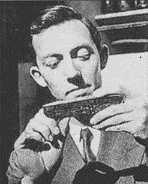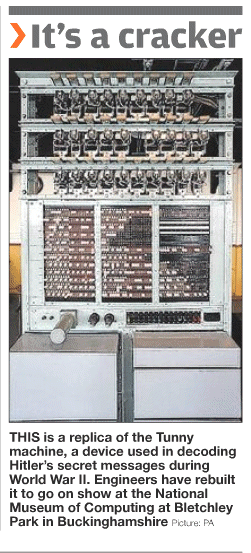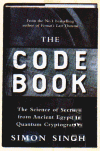 |
The Real X-Files
|
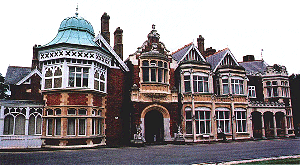 |
| Within these walls...Bletchley Park,the mansion near modern Milton Keynes where German codes were cracked |
The wartime secrets of Bletchley Park,Britain's top level code breaking centre,are brought to light - and it's staff brought to life - in a new series
Geoff Ellis
Teenager cracks e-mail code |
|
| Sarah Flannery, 16, who baffled the judges with her grasp of cryptography They described her work as "brilliant" |
BY AUDREY MAGEE, IRELAND CORRESPONDENT |
| An Irish schoolgirl was yesterday hailed as a mathematical
genius after devising a code for sending secret messages by computer. Sarah Flannery used the science of cryptography to design a code that is ten times faster than the one currently used to convert confidential information so that it can he sent via the Internet and e-mail. She has been inundated with offers of jobs and scholarships from international companies and universities. Miss Flannery, 16, from Blarney, Co Cork, used matrices to formulate an alternative to RSA, the current data protection code, devised by three students at the Massachusetts Institute of Technology in 1977. The result is an algorithm, a mathematical blueprint, that is far faster than the RSA and equally secure. Miss Flannery, whose father, David, lectures in mathematics at Cork Institute of Technology, devised her code to enter the Irish Young Scientists and Technology competition. She won at the weekend and left the judges unable fully to comprehend her project. They described her work as "brilliant" and one judge advised her to patent it. Miss Flannery said she was thrilled. "I had to go through lots of stuff before I finalised the theory," she said. "I reached critical points where I would get stuck for three weeks or so.I just kept thinking about it and then the whole thing slipped into place." The oldest of five children, she earned eight As in her junior certificate, the Irish equivalent of GCSEs, with extra tuition from her father. Miss Flannery is now deciding what to do with her new code, the Cayley-Purser, named after Arthur Cayley, an eminent 19th century Cambridge mathematician, and Michael Purser, a cryptographer who inspired her. She is considering publishing her findings rather than patenting as she does not want people to pay for her discovery. She will represent Ireland at the EU Science Contest in Greece in September. |
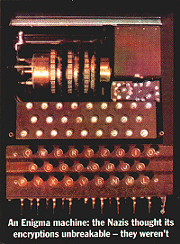
From the sinking of the Bismarck to the D Day landings, British code breakers
had a remarkable influence on the course of the Second World War. Thousands
of young people working under an assortment of intellectuals and academics,
broke German signal codes, including messages between Hitler and his generals.
"
"Never had one side known so much about the enemy's intentions in the history
of warfare," says David Darlow, series producer of
Station X [Ref: Video
N45], named after the radio call sign of the code-breakers at
Bletchley Park in Buckinghamshire.
According to some estimates, the decoding work carried out at the mansion,
near what is now the new town of Milton Keynes, shortened the war by as much
as two years. "The story came out in the seventies when some people were
allowed to speak, but the bulk remained silent. Now some have spoken for
the first time.
"This was a bunch of schoolkids and students, most of whom had never seen a code before. Some were good at crosswords or chess, others were good mathematicians or linguists. They were a weird bunch whose average age was in the early twenties, and it was a curious military establishment - it was the forties equivalent of Silicon Valley."
The work revolved around the codes generated by Enigma, the machine used
by the German armed forces for encoding communications. With Enigma, any
message could be easily translated into groups of five letters transmitted
in Morse code and then decoded by a machine using the same settings. The
difficulty of the task facing the British can be gauged from the number of
settings for an Enigma machine 150 million million million.
But good intelligence work, educated guesses, brilliant analysis and mind-numbing
thoroughness, combined with sloppy German operators, meant signals could
be decrypted in days or hours. "Much of it depended on the mathematical
probability of a particular letter occurring. So machines were built enabling
decryption that took days manually to be done in half an hour," says Darlow.
In fact, they developed the world's first programmable computer but, like
everything at Bletchley, it remained a secret and its designers, notably
mathematician Alan Turing,
never received credit. "Turing," says Darlow, "was the greatest scientific
brain of the mid-20th century, on a par with someone like
Einstein.
"One reason why everything that went on at Bletchley remained a secret was
that the techniques and some of the machines were still in use against the
Russians and even our allies for decades. We've talked to at least 200 people
who worked at Bletchley Park, so it's difficult to believe that there are
any more substantial secrets to come out. "We have used drama to bring alive
the story of the people involved. When you hear people talking about the
satisfaction that comes with breaking a coded message, it sounds like they
could be talking about sex."
News |
World War 2 Encoding Machine stolen from base
An Enigma encoding machine used to send secret messages during World War
2 has been stolen from a former spy centre in Buckinghamshire.
The machine,one of only 3,was stolen from Bletchley Park in Milton Keynes.
Police believe the machine was taken on March31 or during an open day
on Apr1. Police said the machine was worth around £100,000.

Robert Harris : Enigma |
|
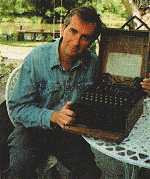 |
Although he was born more than a decade after the end of
the Second World War, Robert Harris has a remarkable ability to recreate
the atmosphere of the war years, as revealed in Fatherland, his first
novel, which sold more than four million hardback copies, and now in
Enigma. Of course, none of this success happened by accident, and
Harris's meticulous research two years' worth went into Enigma is
largely responsible for the accuracy and extraordinary vividness of his settings.
The original source of inspiration for Enigma was a documentary that Harris saw about Alan Turing, the pioneer in computer theory who played a key role in unscrambling the torrent of radio messages transmitted by the 200,000 Enigma machines manufactured by the Third Reich. |
| 'I knew that Enigma was important,' the author
explains, but what was it like at Bletchley Park? Ten thousand people worked
there. I felt curious about how they lived. I like novels that take you inside
another world.' Formerly a BBC researcher and reporter, and later a political
columnist for the Observer and the Sunday Times, Robert Harris does not regret
turning his back on either politics (which he almost entered) or journalism.
The success of his novels has given him the freedom to become a full-time
writer, and to explore in-depth the Second world War, a subject that has
fascinated him since he was a boy of thirteen and first read The Rise
and Fall of the Third Reich. 'I just found it all riveting. Those twelve
years are the crucible of the modern world, possibly the most important in
human history, in what they tell us about what human beings are capable of.'
His first book, Selling Hitler, about the Hitler Diaries fiasco, was nonfiction written in fictionalised style. While writing it, Harris realised that he enjoyed the process of blending fictional narrative with facts. It has proved to be a lucrative combination, enabling him to move with his wife, a BBC producer, and their two children, to a beautiful Berkshire vicarage with a garden that slopes down to the Kennet and Avon canal. ' As my publisher says,' the author comments wryly, "'You can say what you like about Adolf, but he's been good to Robert."' |
|
| WAV 126K | WAV 76K |
Bletchley tale told blandlyThe Enigma codebreakers may have helped to win the war,but a new film about them is no triumph,says Fiona Morrow |
|
|
|
A code breaker and an enigmaAlasdair Palmer on a life of the man who deciphered a 3,500-year-old script
The Man Who Deciphered Linear B: The Story of Michael Ventris.
|
|
||
| MICHAEL VENTRIS fits the template for the romantic
notion of genius. He was brilliant; he was unconventional; he was emotionally
detached; and he died at the age of only 34, having achieved an intellectual
breakthrough for which others had laboured in vain.
|
|||
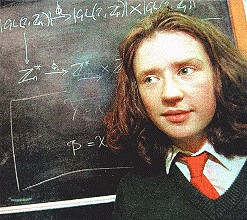

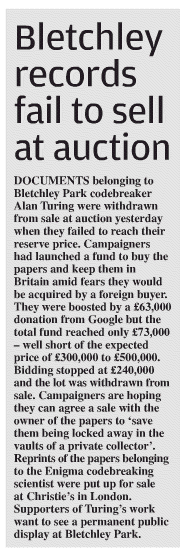 At a full six years from option to final cut, the film of Robert Harris's
bestselling novel Enigma took longer to make it to the screen than
it took the Allies to win the Second World War.
At a full six years from option to final cut, the film of Robert Harris's
bestselling novel Enigma took longer to make it to the screen than
it took the Allies to win the Second World War.
